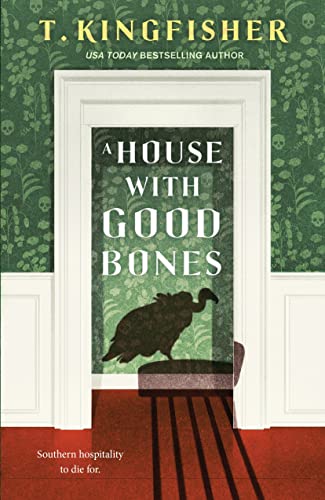
Archaeoentomologist Sam (Samantha) Montgomery, during an interruption in work at a dig site, heads home for the first extended visit to her mother in a while. She’s not taking too seriously her brother’s warning that “Mom seems off,” and isn’t expecting anything other than an enjoyable visit with her mother. The first hint that her brother could be right might be that her mother has redecorated in Gran Mae’s style, including the Confederate wedding painting. Or, it might be the vulture perched outside.
A House with Good Bones, by T. Kingfisher (author), Mary Robinette Kowal (narrator)
Macmillan Audio, ISBN 9781250886361, March 2023
Review by Lis Carey: Samantha (Sam) Montgomery is an archaeoentomologist, returned for a rare extended visit to her mother’s home in North Carolina. She’s been looking forward to it, is excited as she approaches the house, and initially not that worried by her brother’s warning that “Mom seems off.”
Then she walks inside, and the cozy clutter and lively colors of her mother’s house are gone. Most of the walls are various shades of white (Sam is especially horrified by the ecru), while her own old room is rose. Her mother seems oddly timid, and has reimposed her own mother’s, Gran Mae’s, rules, of no swearing, grace before meals, and suggesting more modest clothing. What is she afraid of?
Other oddities soon become apparent. Although Mrs. Montgomery does no gardening, and has no gardener — just a neighbor she pays for mowing and handyman-type tasks — her mother, Sam’s grandmother’s, roses are thriving. Stranger than that, there are no insects in the garden, or anywhere on the property. Gardens need insects to thrive.
Sam starts reconnecting with other neighbors, including the woman her grandmother called “an evil old witch.” The one with the “witch’s garden,” or perhaps, just a garden of native plants in a more natural layout.
There’s something definitely strange about those roses. Some very disturbing features of Gran Mae’s decorating, such as the picture of a Confederate wedding, have reappeared. And Sam is starting to hear voices, in her dreams and in a state called “sleep paralysis,” which is all too familiar to me. You wake up, but not entirely. Not enough to turn off the protective immobilization of the voluntary muscles that keeps us from sleepwalking. There’s often a sense of a threatening presence. Sam is experiencing this, or thinks she is.
Sometimes she hears the voices while awake, elsewhere in the house. They’re telling her to leave. Her brother reminds her of the “underground children” Gran Mae told them stories of.
Sam starts digging for an explanation, behind what’s going on, though everyone is telling her not to. That not all questions need answers. That some questions are better not answered.
Sam is a smart, funny, sarcastic woman, easy to like and care about. Other characters grow in depth and complexity as Sam gets to know them.
I haven’t even mentioned either the ladybugs or the vultures.
The story told in Sam’s funny, sarcastic voice builds toward a genuine horror ending.
Altogether enjoyable, and well-narrated by Mary Robinette Kowal.
I bought this audiobook.
Discover more from File 770
Subscribe to get the latest posts sent to your email.

Clickity
I recently have begun to see horror books on Kindle using Oor Wombat herself as a point of comparison in their blurbs, the way they used to (and still do, of course) use Peter Straub or Stephen King or Clive Barker
Click
I really enjoyed this book – read it immediately on release day, and then enjoyed the audiobook over about a week of bedtimes after that. Yet another of her horror novels featuring a protagonist whose company is just the best. I want to be friends with all of them, and go out for coffee or wine or whatever, and hang out until two in the morning. I imagine them all in some sort of support group for survivors of Seriously Weird Life-Threatening Shit.
If I had even the tiniest quibble, it was that I got a little impatient with the main character’s reluctance deep down the length of the novel to accept that something beyond the realm of SCIENCE! was going on – but I could see where it was very much in her character to look for evidence and testable hypotheses.
The picture painted of the generational legacy of familial abuse was chilling. Reminded me of some of Diana Wynne Jones’s novels – there’s another author who’s quick to remind us that “family” doesn’t always mean “supportive” or “loving” (or that “loving” doesn’t always mean “kind”). Brr.